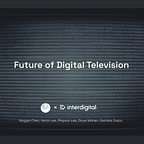InterDigital: Return of the TVs (Ep. 1)
Welcome back everyone…to the future of TV! After a spectacular Spring presentation featuring Obama, Michael Scott, and Tom Cruise, among many of our synthetically generated presenters, we doubled down on our future opportunities, and began preparing for the new season of the CMU Capstone project. Now, where do we begin…
Envisioning the Future
After giving our clients at InterDigital some time to read through our work and digest the proposed opportunity spaces we suggested in our presentation, we conducted a series of visioning sessions with them to gauge which opportunities excited them the most, and decide on the most feasible and appealing design space for the summer. In case you needed a refresher of what our opportunity spaces were, we’ve listed them below:
The Synthetic Shape Shifter: Findings from last semester indicated that TV viewers want the content to adapt to their lifestyle. Additionally, viewers want to use TV content to indulge in their emotions, and have a shared experience with their peers. Through these insights, we believed that synthetic content could help adapt existing TV content to fit the user’s context and lifestyles, specifically their personal, social, and emotional needs.
The Synthetic Time Machine: When creating digital content, we realized users typically want to re-experience their past, and use content as a form of escapism by immersing themselves in their imagination. We believe that in a content creation context, synthetic content can be used to automate the process of not only realistic content creation, but to also help simplify and streamline the process for users to create content that suits their individual needs without prior video editing knowledge.
The Synthetic Helper: In addition to adapting content to people’s lifestyles, our research from last semester indicated that people wanted intelligent systems that could anticipate their needs, and have digital characters that allow them to experience narratives from different perspectives. Through digital doubles and synthetically generated characters, we can meet these needs in a TV viewing context.
Using the Creative Matrix template developed by the LUMA Institute, we began by listing the categories and opportunities in a table format, and then spent time brainstorming scenarios and designs that would make sense for each cell. For instance, how might the synthetic shape shifter be used for entertainment? How can the synthetic time machine enhance travel and education?
Across these different use cases and scenarios, we realized that the underlying systems we had in mind were similar. Thus, drawing parallels across each of the categories, the team designed a high level system diagram that illustrated the end prototype that we would work towards.
We believed that this system was generalizable across the different use cases and scenarios we had in mind. Each arrow indicated the subsystems and interactions that we would design to actualize the system at the end of the semester. Whereas the dark blue arrows illustrated the context-aware TV viewing experience, corresponding to the synthetic shape shifter, the neon green arrows represented the content authoring system that we would also design alongside the TV viewing experience, inspired by the synthetic time machine opportunity space.
Now that we have defined the end goal, let’s begin designing our future TV, shall we?
Sprinting to the Finish Line
To rapidly test and evaluate our design choices, our team has moved towards 5-day sprint cycles, where we quickly define a goal, sketch out ideas, build out a prototype, and test it with our existing user-base that we had screened and recruited from last semester.
Extra, Extra! Interact with it!
As our first prototype, we began by examining the potential use of synthetically generated supplemental material such as digital doubles and synthetically generated videos.
To test this, we used a news article, to emulate a video news report where synthetically generated content is overlaid on top of it when the user wants to learn more about a specific piece of information. We interspersed links across the prototype that our ‘viewers’ must click on as they interact with it.
Upon testing it with a group of 6 participants, we realized that some of our data may not be as helpful due in part to social desirability bias, and the fact that we had no reliable instrumentation to gauge attention and engagement beyond self reported data. As an improvement for next time, we are considering incorporating additional quantitative measures such as eye tracking tools and other psychometric instruments for engagement and attention. Additionally, we will be looking towards A/B testing and repeated measures where we ask participants to view TV content with and without the synthetically generated system.
Are You Happy Yet?
As our second prototype, we consolidated our insights into adaptive TV content. Last semester, we learned that people want TV content to adapt to their lifestyles, regulate their emotions, and they anticipated an intelligent system that could identify their needs. As a result, we designed a prototype around context-awareness, specifically identifying ways to synthetically adapt the content based on a TV viewer’s emotions. To prototype this, we used the ‘choose your own adventure’ TV show “Unbreakable Kimmy Schmidt: Kimmy vs. The Reverend”. We would first ask participants for their prior viewing habits and emotional expectations towards the show. Afterwards, at each point where the plot diverges, we would prompt TV viewers for their current emotional state, and then choose the plot accordingly. From the user’s perspective, the plot would “synthetically adapt” to their emotions, because they are unaware of the plot points in the show, and we would be selecting the plot for them using Wizard of Oz mechanics.
What to Expect this Season
As we begin to wrap up our second prototype and conduct user testing, we will be increasing the fidelity of our system and iteratively adding new subsystems to our prototype, to actualize the high level system that we had envisioned. Stay tuned, as the future of TV is drawing near!
